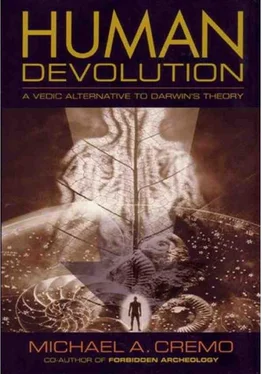Michael Cremo - Human Devolution - A Vedic Alternative To Darwin's Theory
Здесь есть возможность читать онлайн «Michael Cremo - Human Devolution - A Vedic Alternative To Darwin's Theory» весь текст электронной книги совершенно бесплатно (целиком полную версию без сокращений). В некоторых случаях можно слушать аудио, скачать через торрент в формате fb2 и присутствует краткое содержание. Год выпуска: 2003, ISBN: 2003, Издательство: Torchlight Publishing, Жанр: Старинная литература, на английском языке. Описание произведения, (предисловие) а так же отзывы посетителей доступны на портале библиотеки ЛибКат.
- Название:Human Devolution: A Vedic Alternative To Darwin's Theory
- Автор:
- Издательство:Torchlight Publishing
- Жанр:
- Год:2003
- ISBN:9780892133345
- Рейтинг книги:4 / 5. Голосов: 1
-
Избранное:Добавить в избранное
- Отзывы:
-
Ваша оценка:
- 80
- 1
- 2
- 3
- 4
- 5
Human Devolution: A Vedic Alternative To Darwin's Theory: краткое содержание, описание и аннотация
Предлагаем к чтению аннотацию, описание, краткое содержание или предисловие (зависит от того, что написал сам автор книги «Human Devolution: A Vedic Alternative To Darwin's Theory»). Если вы не нашли необходимую информацию о книге — напишите в комментариях, мы постараемся отыскать её.
Human Devolution: A Vedic Alternative To Darwin's Theory — читать онлайн бесплатно полную книгу (весь текст) целиком
Ниже представлен текст книги, разбитый по страницам. Система сохранения места последней прочитанной страницы, позволяет с удобством читать онлайн бесплатно книгу «Human Devolution: A Vedic Alternative To Darwin's Theory», без необходимости каждый раз заново искать на чём Вы остановились. Поставьте закладку, и сможете в любой момент перейти на страницу, на которой закончили чтение.
Интервал:
Закладка:
If the value of ε were even slightly different, there would be major effects on atomic structure. If, for example, the value of ε were .006 instead of .007, this would mean that the strong nuclear force was slightly weaker than it is now. But this would be enough to interrupt the formation of elements heavier than hydrogen. Heavier elements are formed by adding protons to the nuclei of atoms. Hydrogen, with one proton, is the lightest element. Iron has 26 protons. But to get to iron and the heavier elements, we first have to go from hydrogen to helium.The helium nucleus usually contains two protons and two neutrons, while the simple hydrogen nucleus consists of just one proton. So to go from hydrogen to helium requires a middle step, the conversion of hydrogen to its isotope deuterium, which consists of one proton and one neutron. Then two deuterium nuclei can fuse to form a helium nucleus, with two protons and two neutrons. The strength of the nuclear binding force between the protons and neutrons in the helium nucleus causes the release of part of their mass as energy, the binding energy. Now if this binding energy were .006 of the total mass of the protons and neutrons, instead of .007, the strong nuclear force would be weaker. It would be just weak enough so that a neutron could not bind to a proton. Deuterium nuclei could not form, and therefore helium nuclei could not form. The hydrogen atoms would still condense into heavy masses, and these masses would heat up. But there would be no fusion reactions to keep the star going. No other elements would be formed. There would be no planets and no life as we know it.
What if ε was .008 instead of .007, indicating that the strong nuclear force was slightly stronger than it is today? That would lead to a problem of another kind in the process of element formation. As we have seen, the strong nuclear force is needed to bind protons together. Today, the strong force is not strong enough to bind just two protons together. A combination of two protons is called a diproton. There are no stable diprotons in the universe today. This is because the repulsion between the two positively charged protons is stronger than the binding energy of the strong nuclear force. But the binding energy, at its current value of .007, is strong enough to cause a proton to bind to a neutron, thus forming deuterium. And then two deuterium atoms can combine to form helium. This happens because the neutrons supply the extra binding energy needed to bring the two protons together. Because the neutrons are neutral in electric charge, they do not add any additional force of repulsion. Now if ε were .008, then two protons could join together, forming a diproton, an isotope of helium with two protons and no neutrons. This means that all of the hydrogen atoms (each with one proton) in the early universe would quickly combine into diprotons. Today, only some of the hydrogen atoms form deuterium and normal helium, over long periods of time. This leaves hydrogen in the universe for the formation of hydrogen compounds necessary for life. Barrow and Tipler (1996, p. 322) put it like this: “If the strong interaction were a little stronger, the diproton would be a stable bound state with catastrophic consequences—all the hydrogen in the Universe would have been burnt to He2 during the early stages of the Big Bang and no hydrogen compounds or long-lived stable stars would exist today. If the diproton existed we would not!” The most important hydrogen compound is water, and in a universe in which ε was .008, there would be no water. The stable stars would not exist because they require hydrogen for fuel and there would be no hydrogen.
Going from helium to carbon also requires some fine tuning (Barrow and Tipler 1996, pp. 250–253). According to cosmologists, the first generations of stars burn hydrogen nuclei by a fusion process that yields helium nuclei. Eventually, the star runs out of hydrogen, and the helium core of the star begins to become denser. The condensation raises the temperature of the star to the point where helium begins to fuse into carbon. A helium nucleus has two protons. A carbon nucleus has six protons. Theoretically, three helium nuclei could fuse to form a carbon nucleus. But in practice this does not happen, because it is not very likely that three helium nuclei could collide at the same instant in just the way necessary to produce a carbon nucleus. Instead, there is a two step process. First two helium nuclei combine to form a beryllium nucleus, with four protons. Then a beryllium nucleus combines with another helium nucleus to form carbon. The problem is that the beryllium nuclei are unstable and rather quickly break back down into helium nuclei. Therefore, physicists would expect that very little carbon would be produced, certainly not the amounts of carbon present in the universe. But then the English astronomer Fred Hoyle showed that the carbon nucleus just happens to have a particular resonant energy level that lies just above the combined energy levels of beryllium and helium. The additional energy supplied to beryllium and helium by the heat of the solar core brings the beryllium and helium nuclei up to this level, enabling them to combine into carbon nuclei much more rapidly than might otherwise be expected. It is possible that all of the carbon produced in this way could have been immediately converted into oxygen, if the carbon nuclei combined with helium nuclei. But the oxygen nucleus has a resonant energy level that is below the combined energies of carbon and helium. This lucky circumstance means that the fusion reaction between carbon and helium becomes less likely. And therefore we have enough carbon for carbon-based life forms. Rees (2000, p. 50) noted: “This seeming ‘accident’ of nuclear physics allows carbon to be built up, but no similar effect enhances the next stage in the process, whereby carbon captures another helium nucleus and turns into oxygen. The crucial ‘resonance’ is very sensitive to the nuclear force. Even a shift by four per cent would severely deplete the amount of carbon that could be made. Hoyle therefore argued that our existence would have been jeopardized by even a few percentage points’ change in ε.” Commenting on the finely tuned resonances that enabled the production of heavy elements in the stellar interior, Hoyle said, “I do not believe that any scientist who examines the evidence would fail to draw the inference that the laws of physics have been deliberately designed with regard to the consequences they produce inside the stars” (Barrow and Tipler 1996, p. 22).
Ω (omega) and the Cosmic Balance of Forces
According to modern cosmologists, the expanding universe in its very beginnings had three possible fates. (1) The force of gravity could have overwhelmed the force of expansion, and the universe could have rapidly collapsed back on itself, before any stars and galaxies could have formed. (2) The force of expansion could have overwhelmed the force of gravity, so that the universe would have expanded too rapidly for stars and galaxies to form. (3) The forces of gravity and expansion could have been adjusted very carefully so that the universe expanded at just the right speed for stars and galaxies to form and persist over billions of years.
The fate of the universe therefore depends upon a critical average density of matter. According to cosmologists, the critical density is 5 atoms per cubic meter. If the density is more than 5 atoms per cubic meter, gravity will be strong enough to cause the universe to collapse. If the density is much less than 5 atoms per cubic meter, the universe will expand too rapidly for stars and galaxies to form.
The cosmic number omega is the ratio between the critical density and the actual density (Rees 2000, pp. 72–90). If the critical density and the actual density are equal, then the ratio is 1, and hence Ω (omega) = 1. This allows a slowly expanding universe in which stars and galaxies can form, as is the case with our universe. But in our universe, the actual density of visible matter is far less than the critical density. If all visible matter, in the form of stars, galaxies and gas clouds, is taken into account, the actual density is only .04 of the critical density. But observations of the movement of the visible matter have convinced scientists that there must exist another form of matter in the universe, called dark matter. For example, spiral galaxies are shaped like rotating pinwheels, with two or more curving “arms” of stars streaming from a bright central core. When astronomers look at spiral galaxies, they see that they do not contain enough ordinary visible matter to keep the arms curving as closely as they do toward the centers of such galaxies. According to the current laws of gravity, the arms should be less curved. For the galaxies to maintain their observed shapes, they should have ten times more matter than they visibly have. This means there is some “missing matter.” What form does it take? Some astrophysicists suggest the dark matter may be made of neutrinos, strange particles generated during the Big Bang with very small mass, or myriads of black holes of extremely great mass. “It’s embarrassing,” said Rees (2000, p. 82), “that more than ninety per cent of the universe remains unaccounted for—even worse when we realize that the dark matter could be made up of entities with masses ranged from 10-33 grams (neutrinos) up to 1039 grams (heavy black holes), an uncertainty of more than seventy powers of ten.”
Читать дальшеИнтервал:
Закладка:
Похожие книги на «Human Devolution: A Vedic Alternative To Darwin's Theory»
Представляем Вашему вниманию похожие книги на «Human Devolution: A Vedic Alternative To Darwin's Theory» списком для выбора. Мы отобрали схожую по названию и смыслу литературу в надежде предоставить читателям больше вариантов отыскать новые, интересные, ещё непрочитанные произведения.
Обсуждение, отзывы о книге «Human Devolution: A Vedic Alternative To Darwin's Theory» и просто собственные мнения читателей. Оставьте ваши комментарии, напишите, что Вы думаете о произведении, его смысле или главных героях. Укажите что конкретно понравилось, а что нет, и почему Вы так считаете.












